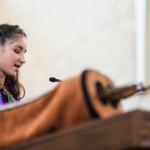 When my medically complicated daughter was only a few years old, a close family member said something that I’ve never been able to forget. I’ve thought about it often, especially as I’ve been writing about my daughter so publicly.
When my medically complicated daughter was only a few years old, a close family member said something that I’ve never been able to forget. I’ve thought about it often, especially as I’ve been writing about my daughter so publicly.
This family member was a new parent with a fussy, unhappy baby. He was complaining that nothing he and his wife were doing to soothe their baby was helping, and I asked if they’d asked any of the parents in their new baby group for ideas.
“No,” he said, “we’re just more private.”
“But maybe someone knows of something — a product or a position or something — that might help,” I countered.
“Look, that’s not how we are,” he answered. “That’s more you. You’d tell any random stranger in your kid’s kindermusic class all about her medical problems no matter what they’d think about you.”
At the time, I felt slapped. I felt hurt, and I felt judged. The tone with which this was delivered was so derisive, as though I was indiscriminately blurting out the story of Sammi’s first cardiac surgery to anyone who didn’t run away when I opened my mouth. It made me feel like an embarrassment.
As I’ve thought about it in the intervening years, though, I’ve been able to separate out what this family member was trying to tell me: that everything about his child felt like a reflection of him, and the less picture-perfect moments were not the ones he wanted to share. For me, all I could imagine was that if just one parent had said to me, in Sammi’s infancy, that they had been frightened by their baby’s fragility, laid awake listening to the sounds of their sick newborn, or had to fight for health care from a specialist, I wouldn’t have felt nearly as alone.
I wish everyone told every random stranger about their children’s medical problems if they thought it might help that stranger. I wish someone had told me.
Somewhere between oversharing and being shut tight is the muddled middle, where we evaluate the potential good that can come of talking about our struggles. There are no sharp edges to this space, only a complex weighing of what feels helpful to us, the person with whom we’re sharing our stories, and the greater good. I like to hope I’m living in that middle.
The essay below appeared in Mamalode Magazine in March of 2015. In my first efforts to raise awareness about the strange congenital heart defect with which Sammi had been born, I wrote this piece that described the interplay of the systems involved — respiratory, circulatory, gastrointestinal — as a dance. Less frightening than the way I would come to see it later, as a tangle, the metaphor of dance was beautifully illustrated by the talented image design Mamalode chose. Mamalode has been a great place to publish, and I always appreciate their careful editing.
How Blood Dances
Originally published in Mamalode
March 5, 2015
Before my younger daughter was born in 2005, I hadn’t thought at all about the delicate parallel dance of air, food, and blood-flow in the human body.
There is a place in all of our chests where these three forces can whisper and beckon to each other from centimeters apart. Air flows down the trachea through our throats and into our lungs. Food and liquid are swallowed and move from the mouth down the esophagus into the stomach. Blood pumps via the aorta, which creates an arc from the heart down to spread and become every other artery in the body. They live so close to each other; I never knew how close. It’s dangerously close.
My daughter Sammi was born with a double aortic arch. Instead of that one graceful, fountain-like arc, her aorta was split in two, both sides pumping blood through and meeting again, together, to stretch into fingers that extended everywhere else in her tiny body. The aortic arch that split and met again created what was known as a vascular ring. The ring encircled her trachea and her esophagus.
Now the whispering between these three conduits—air, food, blood—was overpowered by blood. The double aortic arch quieted the air, quieted the food, made them slaves to its pulse. When her pulse quickened, the arch tightened, trapping food and intensifying the already tight squeeze of air. In the space that could have fit in the middle of my palm, the major systems of her body were at war.
This post was written in response to a Finish the Sentence Friday prompt of “If I could teach the world one thing…” hosted by Kristi from Finding Ninee.






Finding community is always a healing and affirming impulse, and we can’t do that if we don’t share.
I agree. That was always my aim — to create community — and I’ve been happy with the results. After all, it has brought me some precious friends I deeply treasure!
I’ve been that mom, to an amazing son born with hearing loss. You reach out and look for connections, that’s healthy and human.
Thank you for sharing your story.
Joy, I hope you found your connections! I’m glad to hear from you!
Debi I think you make a really important point – it’s only by sharing the ALL of our experience (I mean, maybe not the minutiae but the important bits – the highlights and pitfalls and things we’ve tripped or triumphed over) that we can know that we’re really NOT alone – we get to see that other people out there are like us, have experienced similar things, and can offer us encouragement and support, sometimes just by being there, and having shared the thing which is significant to us, at that time.
Exactly, Lizzi!
I’m so glad that you linked up to Finish the Sentence. It’s so hard when other parents judge us, not even knowing our kids and assuming so much about them. I also relate to the breathing and quickening… Your words “There is a place in all of our chests where these three forces can whisper and beckon to each other from centimeters apart. Air flows down the trachea through our throats and into our lungs.”
I’ve got severe allergies and sometimes can’t breathe at night. So glad you’re creating a community.
There are very few problems that wouldn’t benefit from a new idea or some outside input. Everyone’s privacy preferences are different, but eventually we would all wrestle alligators if we thought it would help! For your allergies at night, have you ever tried a Neti Pot? 🙂
Well, its only medical problems you shared which gives awareness on this condition and people good people may offer their assistance. Their are many people in the world than just you and family, nothing wrong in finding likeminded people who can provide you support and encouragement in some way, it will lift your spirits well(:
I totally agree, Mariam.
The muddled middle indeed!! It’s where we all find a way to get through! Thanks for sharing. I’m here from Finish the Sentence Friday 🙂
Thanks for stopping by, Hillary!
It occurs to me that you are spotting a bad reason for both not sharing and sharing — when a parent makes sharing about a child about the parent and not the child.
People can keep secrets about their children (about health, disabilities, learning issues, sleeping issues, . . . .) to preserve their image of perfection, in ways that limit the child’s access to resources and opportunities (and, one of those resources are caregiver support, that allow a parent to be a better parent to the child).
People can share information about their child, to increase the drama in their own lives, to make themselves interesting, to pat themselves on the back, . . .
I try to think about the separating of me and them when I am talking or making decisions about my children. It’s not easy, and often there are gray zones but reminding myself that my children are not me sometimes helps
This is all so true, zb. I’ve seen evidence of both, many times — and so much of this is about the audience, of course, and the age of the children. Sammi was a toddler when my family member made this comment, and so I felt very much that her privacy around her health was something she was too young to really understand — and especially when she constantly sounded like she was wheezing and congested even when she wasn’t, there were times I just needed to reassure the parents of other children nearby that she wasn’t contagious. As she’s gotten older, I’ve had to think harder about who really needed to hear what.
As for the parents who share information about their children’s health as an attention-grab, I am aware that it can be a fine line. We all tell personal stories both to release some tension that comes from holding that story in AND to create points of connection and validation between us and other people who we think can relate. The danger can come when we turn our own stories into the cautionary tale that every parent needs to accept as their own — when someone whose child has disease XYZ suddenly begins armchair diagnoses of every other child they meet with any coinciding symptom. Heartbreaking as it is to watch others struggle with something we think we can soothe, it is a mark of too much self-absorption when we stop being able to see the world through any eyes other than the ones we’ve used for our own children’s journeys.
That’s a long way of saying: yes, good point.